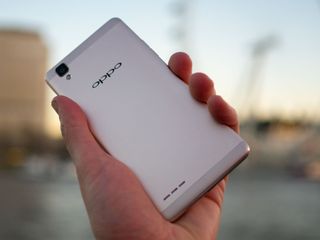First look: The Oppo F1

The trend towards highly-capable budget Android phones in 2015 is set to step up a gear this year, with hardware that would've been considered bleeding edge just a couple of years ago. Case in point: devices like Oppo's new F1, announced today and shown off for the first time in London. We've had the chance to take an early look at the Oppo F1, and we've found a highly impressive piece of hardware — especially considering the €229 (£169) asking price.

A metal body, 720p display and speedy performance combine to form one impressive budget phone.
If you're already acquainted with with Oppo's line of Android phones — primarily sold in Asia — the F1 will be a familiar sight. It's the spitting image of the Oppo R7, the mid-level handset that broke cover in mid-2015. With the F1, the idea is to transform this kind of product into something that costs less than €250, and the result is a handset that feels much classier than its price tag would suggest.
The metal unbody — a sort of rose gold on the models we played with — wraps around the side of the handset, while "2.5D" glass covers the front. You're still dealing with fixed capacitive buttons down below, including the legacy menu button, which continues to feature heavily in Oppo's ColorOS system.



The display beneath that glass is a 720p IPS panel — not as spectacular as the 1080p displays we've seen powering similarly priced devices like the Honor 5X, but the F1's screen looks impressive enough when spread over 5 inches. Powering the whole assembly is a Snapdragon 616 processor — a variation on the Snapdragon 615 we've seen inside a number of mid-rangers over the past year. That's backed up by 3 gigabytes of RAM and 16GB of storage, expandable via microSD. And performance on the whole feels fluid and speedy — we noticed no lag whatsoever in our brief time with the Oppo F1 demo units in London today.
That's due in part to ColorOS, Oppo's highly-customized flavor of Android that favors gradients, elaborate icons and swooping animations. Like Huawei's EMUI, there's quite a bit of iOS influence here, to the point where it might be an entirely unfamiliar experience if you're coming from a Samsung, HTC or Nexus device. Like many Chinese handsets, the F1 is highly-themeable, with additional graphics, skins and wallpapers available to download. Not that you'd notice, but underneath all that ColorOS stuff it's Android 5.1 Lollipop running the show.





Where Oppo's software really shines is in the camera experience. There's a 13-megapixel camera around the back with phase-detection autofocus — the kind favored by more expensive standalone cameras — and an f/2.2 lens. Meanwhile, an 8-megapixel sensor behind an f/2.0 lens lurks around the front, and is capable of producing some impressively crisp selfies, even in in darker conditions. Oppo's camera software is fashioned after Apple's (or Huawei's depending on your perspective), but dig deeper and you'll find more than just a copycat UI — Oppo has pushed the boat out with RAW capture, expert mode for fine manual tuning, and super macro — among a wealth of other options.
We'll have to wait until we've spent more time with the Oppo F1 to draw any firm conclusions, but at first glance this looks to be a powerful, impressive, well-built handset.
Be an expert in 5 minutes
Get the latest news from Android Central, your trusted companion in the world of Android



















Alex was with Android Central for over a decade, producing written and video content for the site, and served as global Executive Editor from 2016 to 2022.